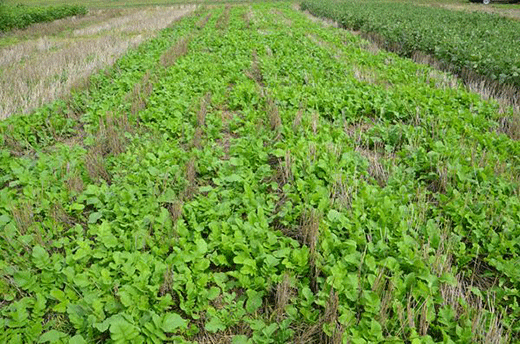
K-State researchers have discovered that cover crops may be a site-specific tool for managing phosphorus runoff.
K-State: Cover crops reduce erosion, fertilizer management cuts phosphorus losses from farm fields
Researchers call diverse conservation practices a ‘1-2 punch’
Aug. 23, 2021
MANHATTAN, Kan. – Kansas State University researchers are finding mounting evidence to indicate the importance of pairing cover crops with improved fertilizer management for controlling phosphorus runoff from farm fields.
But in something of a surprise discovery, recent research has found that cover crops increase the dissolved phosphorus in runoff, which they say heightens the importance of using best management practices when applying phosphorus fertilizer – especially in areas where soil erosion and sediment loss are not a concern.
“We know (from past studies) that cover crops do a great job of reducing sediment loss, and we know that when we reduce sediment loss, we’re also reducing our particulate-bound phosphorus,” said Elliott Carver, a graduate research assistant in K-State’s Department of Agronomy.
Listen to an interview by Eric Atkinson with Elliott Carver and Nathan Nelson on the weekday radio program, Agriculture Today
Phosphorus, nitrogen and other nutrients in fertilizer can negatively affect water quality if those nutrients reach nearby surface water sources, such as lakes and rivers. Fertilizers are added to farm fields to help crops grow; after harvest, cover crops are often planted to help maintain the soil and retain nutrients in the field. Cover crops are especially effective in areas that are highly susceptible to soil erosion.
“Cover crops have done an excellent job of reducing sediment,” said Nathan Nelson, a soil fertility and nutrient researcher at K-State. “Sediment is also an important water quality concern in Kansas. And cover crops are great at (reducing sediment runoff).”
But in fields that are less susceptible to erosion, K-State’s multi-year study – conducted at the Ashland Bottoms Research Center south of Manhattan – discovered that simply planting cover crops may not keep phosphorus from reaching nearby water bodies.
“If our goal is to reduce phosphorus loss, especially in a system where we have normally low sediment loss, adding a cover crop may not be our best management to reduce phosphorus loss,” Carver said. “We need to go back to focusing on fertilizer management.”
Nelson said planting cover crops and implementing best management practices for fertilizing a field work well together.
“You need both of those to reduce sediment and phosphorus loss,” he said. “We still need to collect soil samples and fertilize according to recommendations. Find those areas of the field where there’s no need to fertilize if you don’t expect a yield response. And place fertilizer below the soil surface. There are things like that to help us get the biggest bang for our buck when we’re trying to reduce phosphorus loss.”
Nelson added that K-State’s ongoing study may help producers find ways to manage phosphorus fertilizer application rates, especially in a cover crop system.
“We are trying to understand how cover crops might increase the availability of phosphorus in the soil, whether for crop uptake or loss,” he said. “We have seen that cover crops increase biological activity and have increased several soil factors that would increase phosphorus cycling. These things would lead to increased availability of phosphorus. That is one reason why we might see an increased amount of dissolved phosphorus that is leaving the fields with the cover crops, and makes the effect of cover crops on phosphorus loss variable.”
More research and other topics from K-State’s Department of Agronomy are published each week in the online eUpdate newsletter. Interested persons can also subscribe to have the newsletter delivered by email each week.

